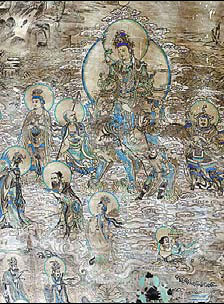
A digital image of part of a Mogao Grottoes mural. Photos by Gao Er'qiang / China Daily
For decades, archaeologist Li Zhirong of Zhejiang University in Hangzhou, Zhejiang province, has been frustrated with her study of China's Buddhist archaeology - or to be more precise, the hundreds of murals in Mogao Gottoes in Dunhuang, Gansu province.
These murals, exuberant with color and movement, dating back thousands of years, await study by scholars. But they are gradually rotting away in the adverse weather conditions of the desert. Another threat: moisture from the likes of human breath.
But a couple of years ago, Li started to work with scholar Diao Changyu and things started to improve. By the end of December 2012, more than 50 of Mogao's fragile colorful murals had been preserved in digital images, an important milestone for the conservation of one of the world's most precious historical relics.
"The most urgent thing for the so-called cultural heritage study at current stage is not to research, but to record," says Li, a student of Su Bai, a famous archaeologist and a pioneer of China's Buddhist archaeology.
"Most of the field survey of Chinese Buddhist archaeology was conducted half a century ago, by foreigners. But with the help of scientific technology, we can catch up with the passing time a little bit."
In 2010, Zhejiang University and Dunhuang Academy teamed up to build a "digital mural file cabinet". The plan is to digitize a minimum of 60 murals within three years.
An exhibition of images of the digitized murals is expected to go on public display early this year at Zhejiang University, allowing people to have a closer look at the glorious art without damaging relics with every exhaled breath.
It's like recreating the environment and conditions of Mogao Grottoes by having a lot of video cameras set at the scene. According to Diao, assistant to director of the Research Center of Archaeometry in Zhejiang University, it is different from taking separate pictures of the objects one by one, because it also accurately records, for example, the distance between two objects, their locations and the process of its discovery.
Diao and his team use a combination of cameras and rails. As the rails extend, the cameras can automatically record mural images at various heights and of different sizes. The picture processing software can reproduce the mural with high accuracy. "The technology not only allows us to preserve what our ancestors left behind before it's taken away by time, but also shows the public how magnificent they are," Li says.
On the ancient Silk Road, the Mogao Grottoes were first constructed in 366 AD. One of the world's richest museums of Buddhist art, the site houses 45,000 square meters of murals and more than 2,000 painted sculptures in its 492 grottoes.
Zhang Jianmin contributed to the story.
Source: China Daily
